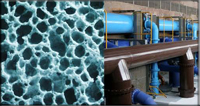
Nov 24, 2025
Blog membrane and separation technology Membrane Bioreactors and the Global Water Revolution
As water scarcity intensifies and environmental regulations become more stringent, the demand for advanced wastewater treatment technologies surges. Among the most promising solutions is the membrane bioreactor (MBR), a technology that seamlessly merges biological treatment with membrane filtration. This powerful combination enhances water quality and enables reuse, aligning with global sustainability goals.
From municipal wastewater treatment to industrial applications, MBRs transform how the world manages water. And with the global market poised for impressive growth, now is the time to explore the drivers, technologies, and regional trends shaping this sector.
According to BCC Research, the global market for membrane bioreactors is estimated to grow from $4.4 billion in 2025 to $9.4 billion by the end of 2030, at a compound annual growth rate (CAGR) of 16.1% from 2025 to 2030.
The global market for membrane bioreactors is witnessing robust growth, driven by increasing urbanization, population pressure, and stricter environmental compliance. As of the mid-2020s, the market is valued at several billion dollars and is expected to grow steadily over the next five to ten years.
Key factors contributing to this market expansion include:
The global market for membrane bioreactors is estimated to grow from $4.4 billion in 2025 to reach $9.4 billion by the end of 2030, at a compound annual growth rate (CAGR) of 16.1% from 2025 to 2030.
A membrane bioreactor (MBR) combines a conventional activated sludge process with a membrane filtration unit (typically microfiltration or ultrafiltration). Unlike traditional systems that rely on gravity for solid-liquid separation, MBRs use semi-permeable membranes to achieve higher-quality effluent and a compact design.
The result? A smaller footprint, fewer pathogens in the treated water, and the ability to reuse effluent for irrigation, cooling systems, or even potable purposes (after further treatment).
Rapid urban growth is stressing water resources and treatment facilities. MBRs are being installed in new city developments and retrofitted in older plants to meet rising demand without expanding plant size.
Environmental agencies across Europe, North America, and the Asia-Pacific are enforcing stringent discharge standards for biochemical oxygen demand (BOD), nitrogen, phosphorus, and pathogens. MBRs help meet these targets with ease.
Regions facing water scarcity, such as the Middle East, California, and parts of India and China, are turning to MBRs for wastewater reclamation, reducing dependency on freshwater sources.
Industries generate large volumes of high-strength wastewater. MBRs offer flexibility, scalability, and the ability to treat complex organic loads, which are especially valuable in the pharmaceutical, food processing, and textile sectors.
With modular designs and remote monitoring becoming more common, MBR systems are even deployed in disaster zones and military operations for mobile water treatment.
Several companies lead the global MBR market, providing membrane modules, integrated systems, and service support. These include:
These players continue to invest in R&D, aiming to reduce membrane fouling, improve energy efficiency, and lower operating costs.
While MBR technology is promising, some challenges remain:
However, these challenges drive innovation in membrane materials, automated cleaning systems, and AI-enabled monitoring, creating opportunities for startups and established players.
Membrane bioreactors (MBRs) represent a crucial evolution in water treatment. They are efficient, compact, and effective at meeting 21st-century environmental demands. As water becomes an increasingly valuable resource, MBRs will play a central role in helping governments and industries close the loop on wastewater.
With global momentum building for sustainable infrastructure, the MBR market is a growing sector, a pillar of circular water management, and a blueprint for future-ready cities and industries.
Consider becoming a member of the BCC Research Library and gain access to our full catalog of market research reports in your industry. Not seeing what you are looking for? We offer custom solutions too, including our new product line: Custom Intelligence Services.
Contact us today to find out more.

Sandeep is a Senior Executive in Marketing Operations at BCC Research, proficiently serving as a graphic designer and content creative specialist. His expertise extends to AutoCAD and Revit, and he has made valuable contributions to the event industry with his design skills.

The global smart water management (SWM) market is rapidly expanding as the world...

We are your trusted research partner, providing actionable insights and custom consulting across life sciences, advanced materials, and technology. Allow BCC Research to nurture your smartest business decisions today, tomorrow, and beyond.
Contact UsBCC Research provides objective, unbiased measurement and assessment of market opportunities with detailed market research reports. Our experienced industry analysts assess growth opportunities, market sizing, technologies, applications, supply chains and companies with the singular goal of helping you make informed business decisions, free of noise and hype.